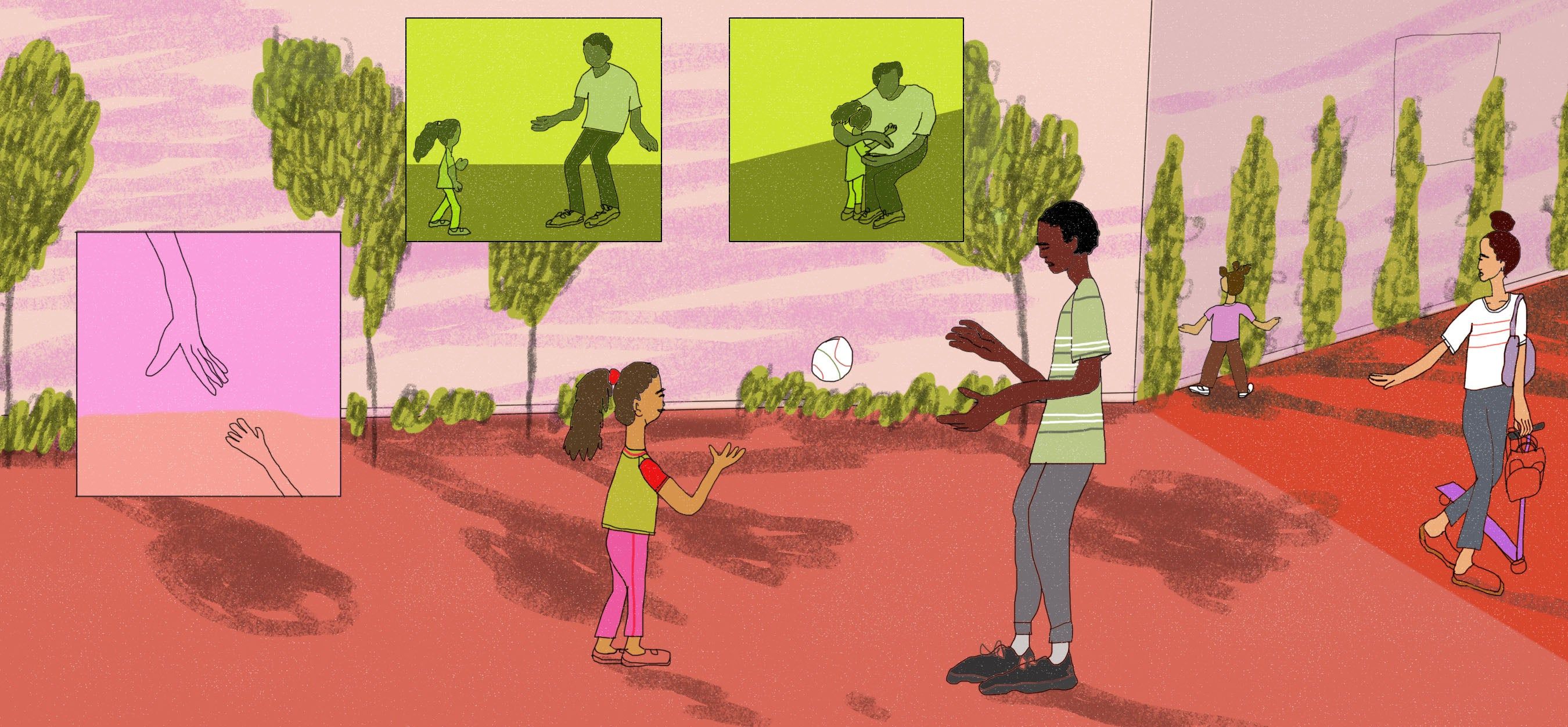
Parenting Styles
What Does Cycle-Breaking Parenting Look Like?
Respectful parenting therapist Dr. Nanika Coor, explores how cycle-breaking parenting techniques can help people who want to connect in healthy ways with their child but have a history of disconnection with their own well-meaning-but-poorly-equipped caregivers.
- Written By
- Dr. Nanika Coor
- Illustration
- Hannah Buckman
People engaged in the activity of raising children usually carry inside of them diverse childhood experiences of having been parented themselves.
As a psychologist specializing in therapy with parents, I’ve certainly held space for parents who experienced profound trauma at the hands of their adults growing up. However, the majority of the parents I work with had well-intentioned but poorly equipped parents–having been raised by poorly equipped parents themselves.
By the time parents seek out my services, they’ve decided that they want to do things differently with their own kids. They want to break that cycle of poorly-equipped parenting and pass down healthier ways of relating to themselves and other people, but they’re unsure how to get started.
Here’s what breaking generational cycles of parent-child disconnection looks like:
Understanding intergenerational cycles of parent-to-child hurt and disconnection
Intergenerational trauma is the relational process by which unresolved trauma in one generation is transmitted to the next generation via the cultural collective, and/or through interpersonal parent-to-child behaviors that are modeled to and experienced by the child such that the child experiences the effects of their parent’s trauma without having experienced the traumatic event themselves.
The term “trauma” refers to the combination of the experience of an event/events together with the after-effects on a person. Anything you experienced in childhood as emotionally or physically harmful or life-threatening and that also left a lasting negative impact on your well-being can be classified as psychological trauma.
When traumas are ongoing, and start in infancy or early childhood they impact your developing brain. As a child, you have a harder time coping with stress and regulating your emotions - making you more sensitive to further harm and more vulnerable to difficulties relating to yourself and to other people. Because of the health problems in adulthood that can result from the behaviors, strategies, and coping mechanisms you developed as a child to protect yourself from the ongoing physical and/or emotional hurt - trauma can affect you throughout your lifespan.
Relational trauma usually occurs within significant relationships with family members. It might include abuse, neglect, maltreatment or major disruptions in the parent-child relationship due to abrupt separation, parental mental illness, or substance abuse. Relational trauma also results from ongoing negative relational patterns, like when parents of infants habitually use conflicting signals, are intrusive, antagonistic, withdrawing and/or consistently don’t provide soothing and comfort.
If you were an infant raised with this kind of habitual lack of attunement, you’re more at risk of transmitting that relational trauma to your own infants through your own parenting behaviors and interactional style.
Resolving your relational traumas through relational safety
Resolving trauma is explicitly working to identify and manage any effects of trauma on you as a person and as a parent. When your trauma is “unresolved” it means that you don’t have a conscious awareness that you’ve experienced trauma or that you aren’t consciously aware of the impact traumas have had on you and the ways you relate to yourself and others.
Parenting with unresolved trauma puts you at risk of unconsciously disrupting the attachment between you and your child, as your unrecognized trauma drives you to act out your traumas in ways that can be traumatizing for your child.
Trauma created within a relationship can only be healed within a relationship. But paradoxically, early relational trauma also affects your ability to feel safe, and to experience empathy and understanding in relationships. Countering the meaninglessness, helplessness, and disconnection involved in early relational traumas requires the creation of new feelings of empowerment, connection, and meaning which can only occur in the presence of new experiences of psychological safety within safe interpersonal relationships.
Developing a healing therapeutic relationship is an ideal place to start. Parents can also find relational safety in community, in trusted friendships, with trusted family members, or even other trauma survivors. Once psychological safety is established, start identifying traumatic experiences and events from the past. Then work to process and mourn what was or what might have been. From here, you can begin to understand and accept the ways in which your trauma impacted your life - for better and worse, and make conscious choices about how you want to move forward in your life and as a parent.
Attuning to your child’s inner experience and your own
Transmitting or preventing intergenerational trauma happens at the level of moment-to-moment parent-child interactions and the relational atmosphere within which they occur. Knowing how to nurture, protect, and sensitively respond to a child is directly related to how well our first significant caregivers were able to do this for us - especially when we were distressed, scared, or otherwise emotionally overwhelmed.
In order to respond in developmentally appropriate ways to a child’s signals, you need the ability to reflect both on your child’s inner experience as well as on your own internal experiences and reactions. You need to understand yourself and your child as separate psychological beings whose behaviors (both internal and external) are influenced by underlying motivations and mental states.
A parent who is able to understand how past trauma impacts their own reactivity to their young child is more able to engage in soothing behaviors despite the fact that their child’s distress triggers memories of their own traumatic experiences.
The more clearly you understand the narrative of your own childhood traumas and their impact on your internal state back then, and in your current life, the more accurately you can attune and respond to your child’s internal state in the present.
Using parenting practices that promote secure attachment
When you’re seeking to break intergenerational cycles of poorly attuned parenting and insecure attachment, it’s helpful to know what makes for secure attachment.
To foster security in the caregiver-child relationship you need to sensitively tune into and respond to your child’s individual way of signaling their needs for comfort, closeness, or autonomy. This attunement to your child’s cues helps you be intentionally mindful of your child's feelings, needs, wishes, rights, beliefs, goals and the unique ways that they live life.
Promoting security means striving to see your child in a positive light - understanding that all of your child’s behaviors are in the service of meeting a need - however unskillful or challenging those behaviors might be. It’s modeling respect in the ways that you interact physically and emotionally with your child and prioritizing your own authenticity as well as your child’s.
Choosing to end cycles of insecure attachment by fostering secure attachment instead also means believing in your child’s competence so that you only help them enough for them to achieve mastery on their own. And instead of adversarial interactions based on rewards, punishments, intrusive control, and coercion, the emotional bond you develop with your child inspires collaboration and cooperation, putting you together on the same team.
Creating a new cycle of secure attachment means creating a safe, predictable environment for your child to develop in the ways they should. Because you are an integral part of your child’s emotional environment, when you are generally predictable – meaning relatively calm, relatively non-depressed and non-anxious, and self-regulated – to your child, they know what to expect from you. Knowing what to expect means their nervous system generally stays calm, or returns to calm easily following tolerable periods of dysregulation. Being clear about the rules of your home and family, and your expectations of your child offers a sense of consistency in the relationship that also contributes to your child’s ability to regulate their nervous system.
Increasing parental resilience by practicing self-compassion
Finally, one of the most important ways to break the cycle of poorly-equipped parenting and promote a secure attachment with your child is to work on the way you relate to yourself.
When you find yourself slipping back into the kinds of unhealthy parenting practices that you’d hoped to leave behind, you might become overwhelmed by or try to suppress feelings of shame, anger, and isolation - or you might engage in a lot of self-criticism.
Instead, try practicing self-compassion. Self-compassion entails three components:
1) self-kindness - responding to difficult emotions in yourself or in your child with support, understanding and self-/child-soothing
2) common humanity - reminding yourself that life challenges and emotional pain are part of the normal human experience that links us together as people
3) mindfulness - nonjudgmental awareness and acceptance of your present experience, including your own or someone else’s difficult emotions or circumstances.
Research suggests that the more you’re able to be self-compassionate in times of distress - such as when your child is struggling with difficult emotions like anger, sadness, or despair - the more likely you are to respond in comforting ways to yourself and your child.
Your children learn through your messages and your modeling how they should deal with challenging emotions and situations. So encourage your child’s emotional expression by meeting their worry, shame, anger, or sadness with acknowledgment and validation. When their upset subsides, facilitate problem-solving by letting them take the lead on coming up with solutions.
A child whose parent has consistently responded to their distress with timely, appropriate and soothing behaviors is more likely to develop self-compassion themselves and more likely to understand and manage their emotions and express them in socially acceptable ways. Kids raised by self-compassionate parents are also more likely to be securely attached to that parent.
A secure bond with your child helps them develop the capacity to regulate their emotions on their own, bolsters their sense of self-worth, resilience and the ability to form trusting relationships in adulthood - all of which they’ll have to pass down to their own children.
Ultimately, breaking the cycle of misattunement and disconnection starts with tuning into and connecting with and healing yourself. To stay motivated, remember that your healing will positively affect many generations to come!
DR. NANIKA COOR

Dr. Nanika Coor is a Brooklyn, New York based clinical psychologist, respectful parenting consultant, and mindful parenting activist helping cycle-breaking parents who don't want their childhood history to become their parenting destiny. Learn more about her work at Brooklyn Parent Therapy.